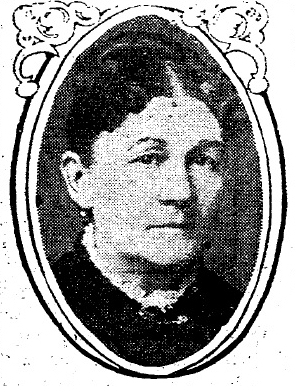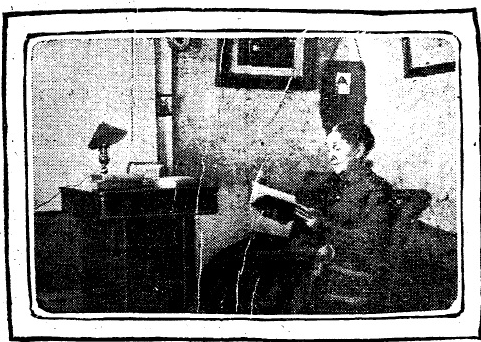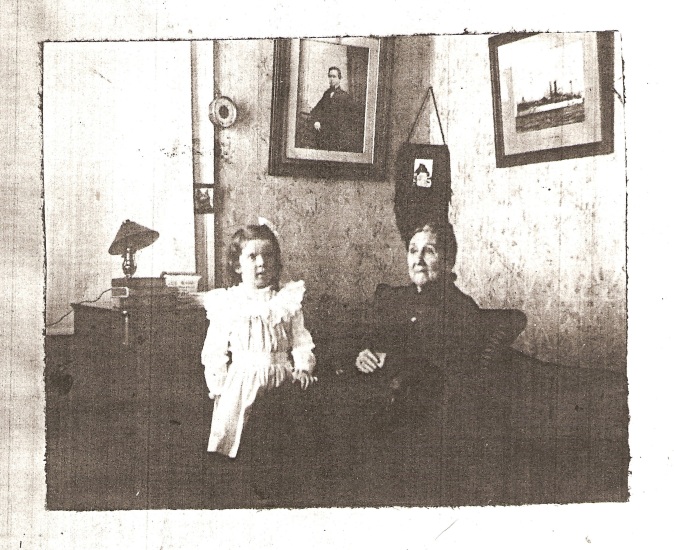
Mary Ann Kidder, a prolific nineteenth-century hymnist, is estimated to have composed more than 1,000 hymns during her lifetime. Upon her death in 1905, the Boston Herald hailed her as “the last of New England’s famous women hymn writers.” While perhaps a bit of an overstatement, it bespeaks of her importance as one of the leading female hymn writers of the late nineteenth century gospel song movement. Today, however, Kidder and her hymns are largely unknown. One of her hymns, “Did You Think to Pray,” is still included in the most recent Latter-day Saint hymnal, but other than birth and death dates, few facts concerning her life are to be found. Much of the following information is from a lengthy obituary published in the Boston Herald two weeks after her death.
She was born Mary Ann Pepper on March 16, 1820, in Boston, Massachusetts, the oldest daughter of master mariner Daniel Freeman Pepper. She spent her childhood in Boston, and began writing poetry at an early age.
When she was sixteen years old Kidder went blind, and it was thought that she would never recover. After about a year, however, her sight was miraculously restored. Her writing career commenced shortly afterward when her poem “The Sailor Boy” was published in one of the papers of magazine editor Nathaniel Parker Willis.
She was married in 1844 to Ellis Usher Kidder, a music publisher employed at A. B. Kidder’s Music Typography, a music printing shop founded by his brother, Andrew Bradshaw Kidder. After their marriage, the Kidders resided at Charlestown, Massachusetts (now part of the city of Boston), where two children were later born: Mary Frances (also known as May), born January 11, 1845, and Edward Ellis, born September 15, 1847. Another son, Walter Bradshaw, was born on July 5, 1853, in nearby Malden, Massachusetts.
The Kidder family moved to New York City in 1857. After the Civil War broke out, Ellis Kidder enlisted as a private in Company C of the 4th Regiment, New York Infantry on May 30, 1861. Mustered in for two years of service, Ellis died of disease on September 23, 1862, at Keedysville, Maryland, just six days after participating in the Battle of Antietam, one of the bloodiest battles of the Civil War. Left alone with three young children to care for, Kidder’s writing hobby became a much-needed source of income. She began to write with greater frequency, contributing both poems and short stories to various magazines and newspapers.
Four years after the death of her husband, Kidder’s home was once again beset with tragedy. On August 3, 1865, on a visit to Somerville, Massachusetts, her youngest son Walter drowned while swimming. Eighteen years later, her only daughter Mary Frances passed away on April 11, 1883, of heart disease. “May,” as she was known, was a talented sketch artist.
Mrs. Kidder was active in the temperance movement and was one of the first members of the Sorosis club, the first women’s club in the United States. She was a religious woman, but as her daughter-in-law Augusta explains, “[she] was not hedged about by doctrinal or a dogmatic belief. She was a deedest, not a creedest, believing fully in the humanitarian idea of tolerance.” Most of the available biographical sketches on Kidder claim she was a Methodist, but evidence suggests she may have been a member of Charles Force Deems’ non-denominational Church of the Strangers, in New York City.
Kidder loved children and animals, and was described by her daughter-in-law as gentle, patient, and always serene. “Nothing ever marred her serenity, and everybody found in her a sympathetic listener.” She was fiercely independent and refused to lean on others for support, mentally and materially. “Absolutely fearless she was too, but not courageous,” said Augusta. “At the age of eighty-four I took her automobiling for the first time. Thinking it was a novel experience for an old lady, as we were tearing along I asked her if she was afraid. ‘Not a bit.’ was the reply; ‘why should I be? I wouldn’t mind going up in a balloon.’ Her will was of iron, but she never allowed her ideas to interfere with another’s; she respected every one’s opinion.”

Kidder was a prolific writer, and it was claimed that she averaged two poems per week during the last sixty years of her life. For more than twenty five years she contributed a poem each week to the New York Ledger, and at the time of her death she was contributing a poem a week to both the Waverly Magazine and the New York Fireside Companion. Other periodicals to which she frequently contributed include Demorest’s Monthly, Packard’s Monthly, and the New York Weekly. In her later years Kidder began writing “passionate love poems,” although her son Edward, a noted playwright, maintains this was purely “for revenue only.” The Boston Herald estimated that during her lifetime Mrs. Kidder earned more than $80,000 from her verse.
But it is her hymns for which she is remembered today. Some of her best-known hymns include “We Shall Sleep, but Not Forever” and “Is My Name Written There?” According to her daughter-in-law, Kidder was modest about her writing talent. “She utterly rejected the idea that she possessed even ordinary talent as a versifier but was vain about her sewing, and the dear little mother-in-law was no sewer at all. In her lifetime I have never seen her sew 20 stitches at a time, yet she would love to pose as a beautiful seamstress.”
In 1903 Kidder returned to Chelsea, Massachusetts to live at the home of her brother, Daniel W. Pepper, where she died on November 24, 1905. She is interred at Woodlawn Cemetery in Everett, Massachusetts.
One of Kidder’s best-known poems is “The Golden Side,” originally published in the New York Ledger on December 14, 1867:
The Golden Side
There is many a rest in the road of life,
….If we only would stop to take it;
And many a tone from the better land,
….If the querulous heart would make it!
To the sunny soul, that is full of hope,
….And whose beautiful trust ne’er faileth,
The grass is green and the flowers are bright,
….Though the wintry storm prevaileth.
Better to hope though the clouds hang low,
….And to keep the eyes still lifted;
For the sweet blue sky will soon peep through,
….When the ominous clouds are rifted!
There was never a night without a day,
….Or an evening without a morning;
And the darkest hour, as the proverb goes,
….Is the hour before the dawning.
There is many a gem in the path of life,
….Which we pass in our idle pleasure,
That is richer far than the jeweled crown
….Or the miser’s hoarded treasure;
It may be the love of a little child,
….Or a mother’s prayers to heaven,
Or only a beggar’s grateful thanks
….For a cup of water given.
Better to weave in the web of life
….A bright and a golden filling,
And to do God’s will with a ready heart,
…And hands that are swift and willing,
Than to snap the delicate, minute threads
….Of our curious lives asunder;
And then blame Heaven for the tangled ends,
….And sit and grieve and wonder.

Notes:
*Mary Ann Kidder sometime published her hymns under the pseudonym “Minnie Waters.” It is not known if she used other pen names.
*In the current Latter-day Saint hymnal her name is listed as Mary A. Pepper Kidder.
*The above photographs of Mary Ann Kidder are all newly discovered and have not (as of November 2018) been republished elsewhere. It should be noted that her jet black hair never turned grey, and according to her daughter-in-law, “this was a real grief to her, for she loved soft, white hair in elderly people.”
*The year the Kidders moved to New York City is inferred from a statement made by her son, Edward Ellis Kidder, in an 1896 interview with the New York Dramatic Mirror. In this interview he reminisced about attending the Bowery Theatre in New York City in 1857, and stated: “New York has been my home since I was ten years of age.”
*The Church of the Strangers was founded in New York City in 1868 by the Reverend Charles Force Deems, and was the church attended by the Cary sisters, Alice and Phoebe. The evidence suggesting Kidder may have attended this church is merely circumstantial. When this church relocated from its original location to Mercer Street in 1870, Kidder wrote a poem for the Reverend Deems to use for the opening of his new church building, and later, in 1883, the funeral of her daughter, May, was held at this church.
*One of May Kidder’s drawings is included in Edwin Dwight Babbit’s book The principles of Light and Color (New York: Babbitt & Co., 1878), 24. Babbit writes: “This pretty piece of landscape was drawn for me by a young artist, Miss May Kidder, daughter of Mrs. M. A. Kidder, the well known poetess.” It is not known when she began to draw, but in the 1860 United States Census, when she was only fifteen years old (and still living at the home of her parents), May’s occupation was listed as “artist.”
*Edward Ellis Kidder (1847-1927) began his career as a theatrical agent, managing stars such as Lotta Crabtree, before becoming a playwright. He wrote more than thirty plays for Broadway, the most successful being “A Poor Relation” (1889), starring Sol Smith Russell, and “Peaceful Valley” (1893). Many of his works were later adapted for motion pictures, including “Sis Hopkins,” “Shannon of the Sixth,” ‘Peaceful Valley,” and “A Poor Relation.” Upon his passing in 1927, the editor of the Brooklyn Daily Eagle remarked: “Plenty of admirers, most of whom are fast growing old, will regret the passing of Mr. Kidder. He did something for forty years to dignify the lighter American drama.” (November 20, 1927.) Many of Kidder’s scripts, dated 1883-1911, are housed in special collections at the New York Public Library.
*August Raymond Kidder (ca.1856-1939), wife of Edward Ellis Kidder, was a playwright and journalist. She was born in Brooklyn, a daughter of Ralph G. Raymond, second cousin to New York Times founder Henry Jarvis Raymond. She wrote a column for the New York Recorder under the pen name “Polly Pry,” and was later a columnist for the New York Herald.
Biographical Sources:
“Last of New England’s Famous Women Hymnologists,” Sunday Herald (Boston), December 10, 1905, Women’s Section, 7; “Mrs. Kidder, 86, Dead,” Boston Daily Globe, November 26, 1905, 15; Alphonso A. Hopkins, Newspaper Poets; Or, Waifs and Their Authors (Rochester, New York: Rural Home Publishing Company, 1876), 121-127; Mary Noel, Villains Galore: The Heyday of the Popular Story Weekly (New York: The MacMillan Company, 1954), 221; Fanny J. Crosby, Memories of Eighty Years (Boston: James H. Earle & Company, 1906), 136; “Mortuary Notice,” New York Herald, April 13, 1883; A. E. B.,“Mirror Interviews,” New York Dramatic Mirror, July 25, 1896, 7; Eva Munson Smith, Woman in Sacred Song (Oakland, Cal.: Arthur E. Whitney, 1888), xxiv; Morgan Hewitt Stafford, A Genealogy of the Kidder Family (Rutland, Vermont: The Tuttle Publishing Co., Inc., 1941), 279; “Massachusetts Deaths, 1841-1915,” database with images, FamilySearch (https://familysearch.org/ark:/61903/1:1:NWJ5-WK4 : accessed June 10, 2010), Mary A Pepper Kidder, 24 Nov 1905; citing Chelsea, Massachusetts, v. 32 no. 437, State Archives, Boston; FHL microfilm 2,070,630.